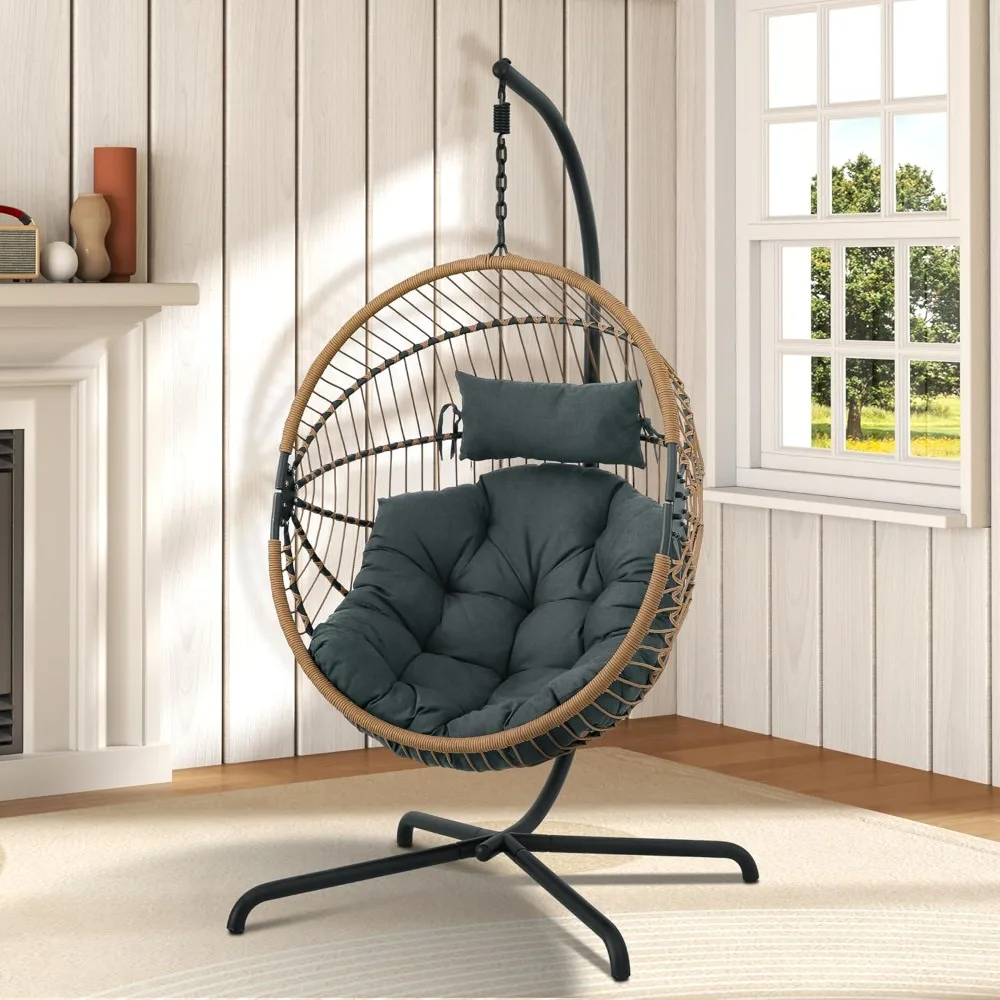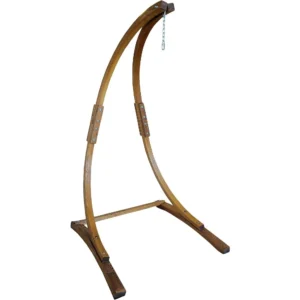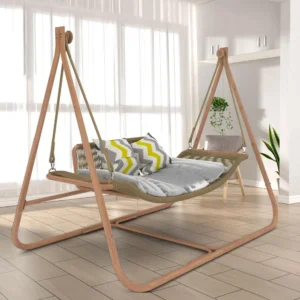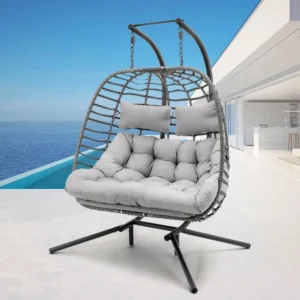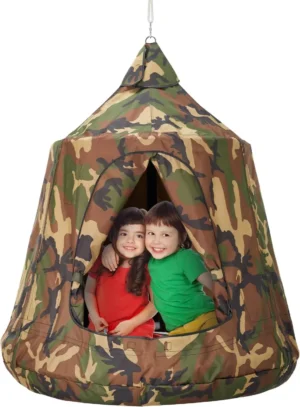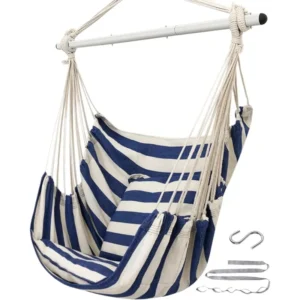Introduction: The Allure of the Hanging Egg Chair
When you first spot a hanging egg chair in a home design magazine or while scrolling through Instagram, it’s hard not to be captivated. These cocoon-like seats suspended in air have become a must-have statement piece for both indoor and outdoor spaces. However, the enchantment often fades momentarily when you check the price tag—typically ranging from $300 to well over $1,500.
“Why so expensive?” is the natural reaction many shoppers have when considering these distinctive pieces of furniture. If you’ve found yourself wondering the same thing, you’re not alone. The truth is, several legitimate factors contribute to the premium pricing of quality hanging egg chairs.
At Outside Luxe, we’ve seen firsthand how understanding these cost factors helps customers make informed decisions about their outdoor relaxation investments. Whether you’re just curious or actively shopping for the perfect hanging egg chair for your space, this breakdown will help you understand exactly what you’re paying for beyond just a trendy piece of furniture.
Premium Materials: The Foundation of Quality and Durability
When you invest in a high-quality hanging egg chair, a significant portion of the price goes toward superior materials that directly impact both longevity and comfort. Unlike disposable furniture, premium egg chairs are built to last for years, even in challenging outdoor conditions.
Material Quality Breakdown:
Frame Construction: Premium chairs feature powder-coated steel or aluminum frames engineered to support weights of 300-400 pounds (135-180 kilograms) safely. This powder-coating process—where paint is electrostatically applied then cured—creates a durable finish that prevents rusting and corrosion, extending the chair’s lifespan by many years.
Rattan/Wicker Quality: High-end chairs use commercial-grade PE (polyethylene) synthetic rattan rather than natural rattan or cheap plastic. This material maintains its appearance despite sun exposure, doesn’t crack in cold weather, and withstands moisture without warping—qualities that basic versions simply don’t offer.
Cushion Materials: The difference between budget and premium egg chair cushions is substantial. Premium models feature high-density foam cores (2.5-3.0 pounds per cubic foot) that maintain their shape even after years of regular use, while budget options often flatten within months. Additionally, quality upholstery fabrics offer UV protection, water resistance, and superior fade resistance.
Hardware Components: While often overlooked, premium chairs utilize marine-grade stainless steel hardware that resists corrosion, while less expensive options typically use standard steel components that deteriorate quickly outdoors.
The material quality difference becomes particularly evident after a year of use—budget chairs typically show significant wear, while premium hanging egg chair sets maintain their structural integrity and appearance. This material difference alone can justify a substantial portion of the price differential.
Complex Design and Manufacturing Process
The distinctive egg shape that makes these chairs so appealing is also responsible for their complex manufacturing process. Unlike standard furniture that can be mass-produced using automated processes, quality hanging egg chairs require significant skilled handwork.
The creation of a premium hanging egg chair typically involves:
Precision Frame Formation: Crafting the curved steel frame requires specialized bending equipment and skilled metalworkers to achieve the perfect ergonomic curve.
Hand-Weaving Process: The signature rattan or wicker shell isn’t simply molded plastic—it’s meticulously hand-woven by skilled artisans. A single premium chair can require 20-30 hours of weaving work alone, with craftspeople following specific patterns to ensure both aesthetic appeal and structural integrity.
Balance Engineering: Creating a chair that hangs safely requires precise calculations for weight distribution and center of gravity. Engineers must design suspension points that distribute weight evenly while allowing for the chair’s natural swinging motion.
Multi-Stage Assembly: Unlike flat-packed furniture, egg chairs require complex assembly processes where components must align perfectly. Quality control at each stage ensures the chair will remain sturdy and balanced.
This labor-intensive process stands in stark contrast to mass-produced furniture, where automated processes keep costs down but often sacrifice quality and attention to detail.
Safety Standards and Testing Requirements
When you’re suspended several feet off the ground in a hanging chair, safety becomes paramount—and meeting rigorous safety standards adds significantly to production costs.
Quality hanging chairs undergo extensive testing for:
Static Load Capacity: Premium chairs are tested to support significantly more than their stated weight capacity to provide a substantial safety margin. While many chairs advertise a 250-pound capacity, quality chairs are typically tested to support 400+ pounds without structural compromise.
Dynamic Movement Testing: Beyond static weight, chairs must be tested for thousands of cycles of swinging motion to ensure they maintain structural integrity over time.
Mounting Point Reinforcement: The suspension points receive particular scrutiny, with reinforced mounting hardware and additional support structures that budget models often lack.
Stability Testing: Chairs with stands undergo additional testing for tipping resistance and base stability, ensuring they remain upright even with active movement.
The more thorough the safety testing, the higher the production costs. Premium manufacturers exceed minimum requirements to ensure their hammock chairs and stands meet the highest safety standards. This is particularly important for hanging furniture where structural failure could lead to injury—something worth considering when evaluating how much weight a hammock chair can hold.
Ergonomics and Comfort Engineering
That cloud-like comfort you experience in a quality egg chair doesn’t happen by accident—it’s the result of sophisticated ergonomic design and comfort engineering that adds to the overall cost.
Premium hanging egg chairs are designed with:
Body-Conforming Contours: The curved shape is specifically engineered to cradle the body in a semi-reclined position that distributes weight evenly and reduces pressure points.
Strategic Support Zones: Quality chairs incorporate additional support in key areas like the lower back and neck to promote proper spinal alignment.
Multi-Density Cushioning: Rather than uniform foam, premium chairs often feature variable-density cushioning that provides firmness where needed and softness in other areas.
Suspension Calibration: The hanging mechanism is carefully calibrated to provide just the right amount of gentle movement without excessive swinging or instability.
These benefits of egg-shaped hanging chairs result from extensive research and development—a process that involves multiple prototypes, ergonomic testing with diverse body types, and refinement based on user feedback. Budget chairs typically skip these steps, resulting in less comfortable seating that may cause discomfort during extended use.
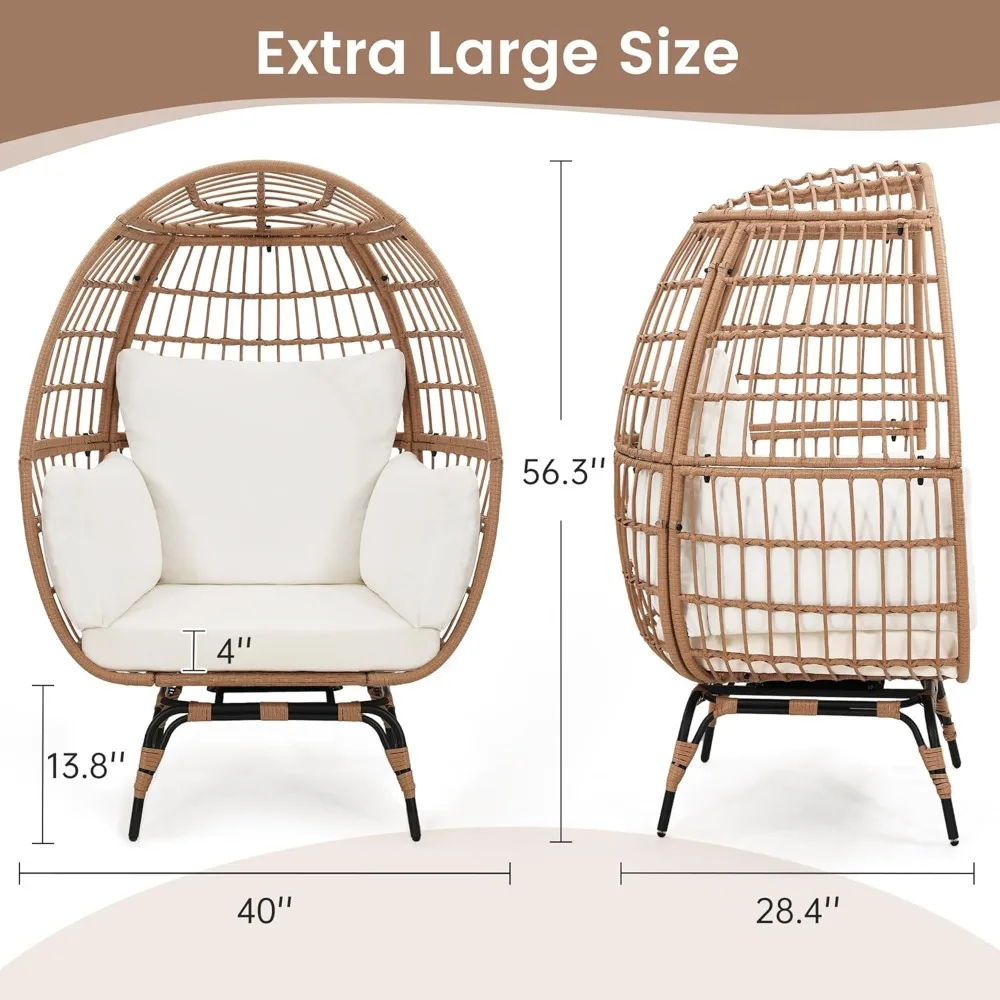
Weather Resistance and Outdoor Durability
When designed for outdoor use, quality egg chairs incorporate sophisticated weatherproofing features that significantly impact their price. These weather-resistant properties determine whether your chair will look great for seasons to come or deteriorate after just one summer.
Premium indoor-outdoor hanging egg chairs include:
Advanced UV Protection: High-quality synthetic materials incorporate UV stabilizers that prevent fading and degradation even after 5,000+ hours of sun exposure (equivalent to several years of outdoor use).
Water Management Systems: Quality chairs feature both water-resistant materials and strategic drainage points that prevent water accumulation during rainstorms.
Temperature Tolerance: Premium materials maintain structural integrity through temperature extremes from below freezing to intense summer heat without becoming brittle or warping.
Mold and Mildew Resistance: Quality chairs incorporate antimicrobial treatments in their materials to prevent the growth of mold and mildew in humid conditions.
These weatherproofing features dramatically extend the chair’s lifespan but add considerably to production costs. Budget options might look similar initially but typically lack these protective qualities, explaining why they deteriorate quickly when used outdoors. For versatile outdoor seating options, swinging hammock chair sets often incorporate these same durability features.
Aesthetics and Designer Influence
Hanging egg chairs aren’t just functional furniture—they’re statement pieces with design heritage tracing back to iconic mid-century modern creations like Arne Jacobsen’s original egg chair. This design pedigree contributes significantly to their perceived value and price.
Premium egg chairs feature:
Harmonious Proportions: The distinctive egg shape follows specific design proportions that create visual balance—not just any curved shape will achieve the same aesthetic impact.
Clean, Flowing Lines: Quality chairs feature smooth transitions and precisely executed curves that create an elegant silhouette.
Thoughtful Detail Work: Premium models incorporate subtle design details like precision edge finishing, pattern consistency, and thoughtful color coordination.
Design Exclusivity: Some manufacturers hold design patents or employ noted designers to create distinctive variations, adding to both uniqueness and cost.
These aesthetic qualities transform egg chairs from simple seating into sculptural elements that enhance your entire space. The design impact is a significant part of what you’re paying for—an instant visual upgrade that basic furniture simply can’t provide.
Brand Reputation and Market Positioning
Established brands command higher prices partly because they’ve invested in building a reputation for quality and consistency. This brand premium isn’t just about the name—it typically reflects substantial differences in:
Quality Control Standards: Premium brands maintain strict quality control processes with multiple inspection points, rejecting components that don’t meet specifications.
Warranty Support: Higher-priced chairs often come with more comprehensive warranties backed by companies with the financial stability to honor them long-term.
Customer Service Infrastructure: Established brands invest in support teams that can address issues promptly and effectively.
Product Development Investment: Leading manufacturers continually refine their designs based on customer feedback and material innovations.
At Outside Luxe, we’ve found that customers often return to quality brands despite higher prices because the overall ownership experience—from purchase through years of use—proves more satisfying than with budget alternatives.
Cost Comparison: Budget vs. Premium Options
Understanding what to expect at different price points helps clarify the value equation when shopping for hanging egg chairs:
Entry-Level ($200-400):
- Materials: Basic steel frames with thin powder coating; low-grade synthetic wicker; thin cushions with standard fabric
- Design: Simple construction with minimal ergonomic considerations
- Durability: Typically 1-3 years when used outdoors
- Weight Capacity: Usually limited to 250 pounds or less
- Features: Basic functionality with minimal weather resistance
Mid-Range ($400-700):
- Materials: Heavier gauge steel with better powder coating; improved synthetic rattan; medium-density cushions
- Design: Better attention to ergonomics and visual details
- Durability: Generally 3-5 years of outdoor use
- Weight Capacity: Typically 300-350 pounds
- Features: Better weather resistance and some additional comfort features
Premium ($700-1,500+):
- Materials: Commercial-grade construction throughout; high-density cushions with premium fabrics
- Design: Sophisticated ergonomics with attention to all design details
- Durability: 7-10+ years even with regular outdoor use
- Weight Capacity: Often 350-450 pounds
- Features: Comprehensive weatherproofing, superior comfort engineering, potentially including additional features like 360° swivel mechanisms
The long-term value proposition becomes clear when you consider replacement frequency—purchasing one premium chair that lasts 8+ years is ultimately more economical than replacing a budget chair every 2-3 years, making quality hanging egg chairs worth the money for many buyers. For additional seating options at different price points, consider browsing deep seat chair hammock sets.
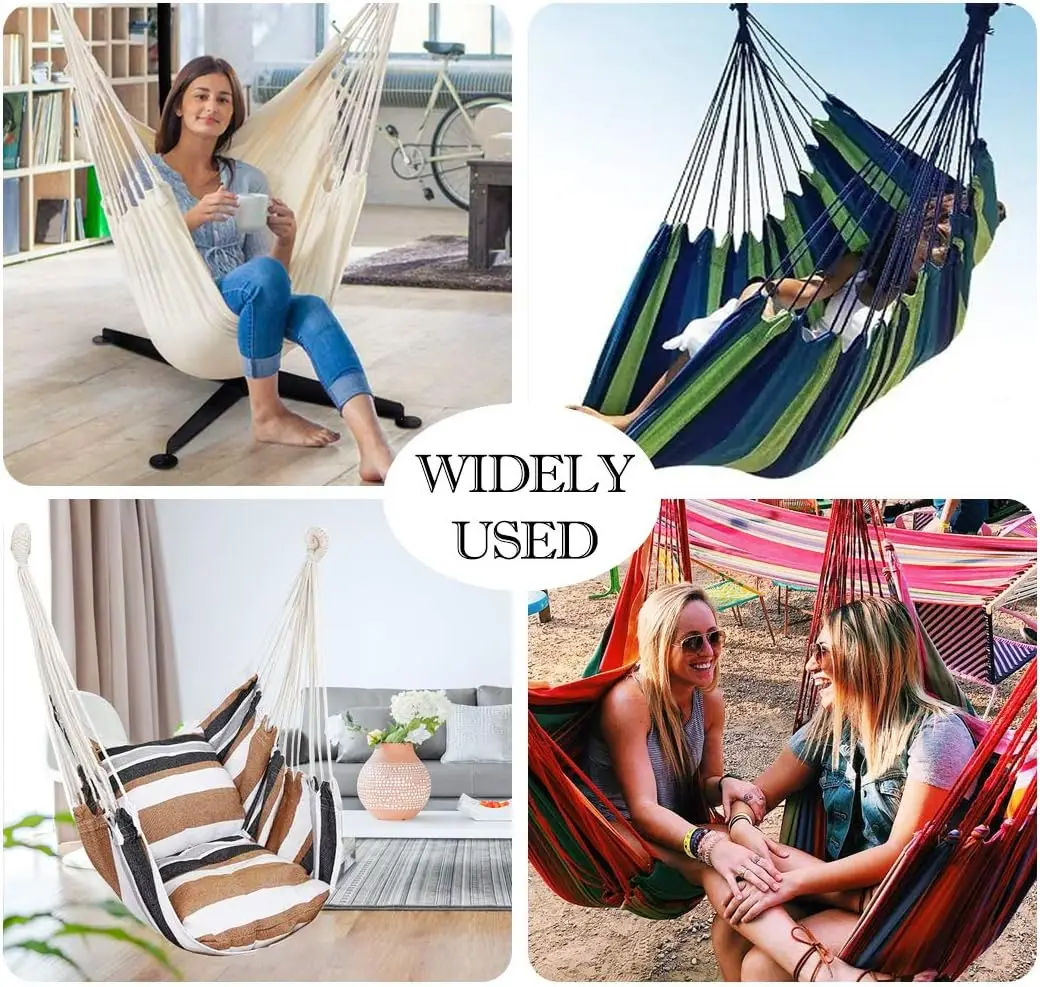
Long-Term Value: An Investment Perspective
When considering the seemingly high price tag of premium egg chairs, thinking in terms of cost-per-year offers valuable perspective:
- A $300 chair that lasts 2 years costs $150 per year of use
- A $900 chair that lasts 8 years costs $112.50 per year of use
Beyond basic durability, premium chairs also offer:
Consistent Comfort: Quality chairs maintain their supportive properties over time, while budget options quickly develop uncomfortable sagging.
Appearance Longevity: Premium materials retain their color and texture for years, whereas budget options often fade and degrade visually within a single season.
Resale Value: Well-maintained premium furniture often retains significant resale value, something rarely true of budget alternatives.
This “buy once, cry once” philosophy often proves financially sound for furniture you plan to enjoy for years to come.
Dark Wood Hammock Sets, Porch Swing Chair Sets
$653.82 Select options This product has multiple variants. The options may be chosen on the product pageA-Frame Stand Hammock Sets, Swinging Hammock Chair Sets
$154.62 Select options This product has multiple variants. The options may be chosen on the product pageLight Wood Hammock Sets, Swinging Hammock Chair Sets
$1,359.35 Select options This product has multiple variants. The options may be chosen on the product page- $963.29 Select options This product has multiple variants. The options may be chosen on the product page
Complete Camping Hammock Systems, Hanging Egg Chair Sets
$266.73 Select options This product has multiple variants. The options may be chosen on the product pageDeep Seat Chair Hammock Sets, Hanging Egg Chair Sets
$165.85 Select options This product has multiple variants. The options may be chosen on the product page
What to Look For When Buying a Hanging Egg Chair
Armed with understanding about what drives hanging egg chair costs, you can make smarter purchasing decisions by focusing on these key quality indicators:
Frame Construction:
* Look for seamless welding at connection points
* Verify substantial weight (lighter isn’t better for frames)
* Check for thick, even powder coating without thin spotsRattan/Wicker Quality:
* Examine weaving tightness and consistency
* Check for smooth, rounded edges without sharp points
* Verify UV-resistant materials for outdoor useCushion Assessment:
* Press into cushions—quality foam springs back quickly
* Verify removable, washable covers for easier maintenance
* Check seam stitching quality—tight, even stitches indicate better constructionHardware Examination:
* Look for stainless steel or heavy-duty galvanized hardware
* Verify that mounting components have safety features like locking carabiners
* Check that all hardware is included and properly sizedStability Testing:
* Gently rock the assembled chair to check for wobbles or creaks
* Verify the stand has a wide, stable base if included
* Check that the hanging mechanism allows smooth movement without excessive swing
Learning how to style hanging egg chairs in your space will also help you select the right design for your needs. For alternative hanging chair styles, browse our selection of porch swing chair sets that offer similar relaxation benefits.
Are Expensive Egg Chairs Worth It? The Final Verdict
After examining all factors that contribute to hanging egg chair prices, we can draw some balanced conclusions:
Premium hanging egg chairs justify their higher price tags primarily through superior materials, craftsmanship, safety engineering, and longevity. For users who plan to enjoy their chair regularly and keep it for many years, the investment often proves worthwhile both financially and in terms of the superior experience provided.
However, the value equation depends significantly on your specific circumstances:
- For occasional use in protected environments, mid-range options may provide sufficient quality
- For primary outdoor seating that will see daily use, premium construction typically delivers better long-term value
- For indoor use where weather resistance is less critical, you might prioritize comfort and aesthetics over extreme durability
The right choice ultimately depends on your usage patterns, budget constraints, and quality expectations. Understanding what drives the costs helps you make an informed decision that balances immediate price concerns against long-term enjoyment.
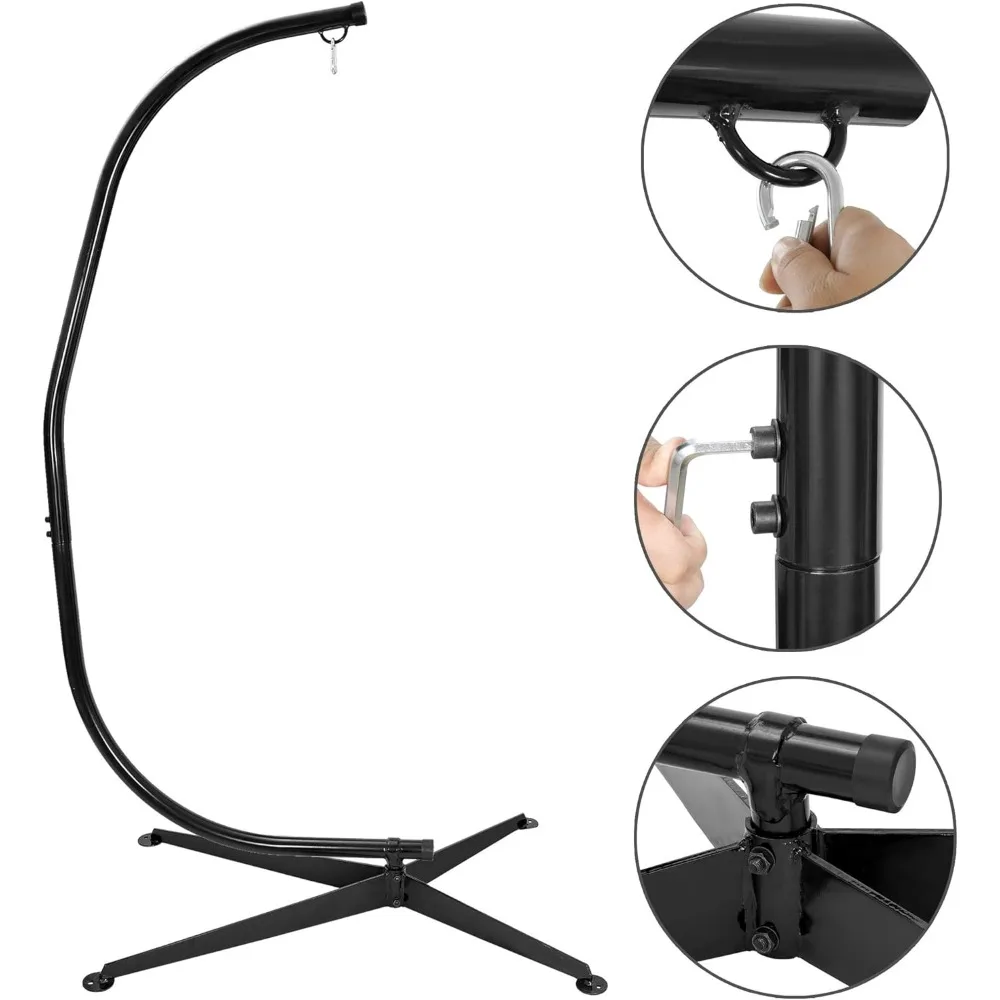
How to Maximize Your Egg Chair’s Lifespan
Regardless of how much you spend on a hanging egg chair, proper maintenance dramatically extends its useful life:
- Seasonal Protection: Use furniture covers or store chairs in protected areas during severe weather or extended periods of non-use
- Regular Cleaning: Gently clean frames and wicker with mild soap and water; avoid harsh chemicals that degrade materials
- Cushion Care: Rotate cushions regularly to promote even wear; store indoor during extended rainy periods
- Hardware Maintenance: Periodically check and tighten all hardware connections; apply rust inhibitor to non-stainless components
- Proper Use: Stay within weight capacity limits; avoid standing on chairs or allowing children to use them as play equipment
Proper hanging chair installation and maintenance can add years to your chair’s useful life, maximizing your investment regardless of initial price point.
FAQs About Hanging Egg Chair Pricing and Quality
Can I find a good quality egg chair under $400?
While rare, you can occasionally find decent quality at lower price points, particularly with indoor-only models or during significant sales. Look for heavier-gauge steel and pay special attention to weight capacity ratings and cushion quality.
What’s the difference between indoor and outdoor egg chairs?
Outdoor versions incorporate UV-resistant materials, water-resistant cushions, and corrosion-resistant hardware—features that significantly increase production costs but extend lifespan in outdoor conditions.
How can I tell if an egg chair will last?
Beyond price, check weight ratings (higher generally indicates stronger construction), material specifications (look for commercial-grade terms), warranty length (longer warranties suggest manufacturer confidence), and customer reviews focusing specifically on long-term durability.
Are name-brand chairs significantly better than generic options?
While not universally true, established brands typically maintain more consistent quality control standards and offer better warranty support. The price premium often reflects these tangible differences rather than simply paying for a name.

